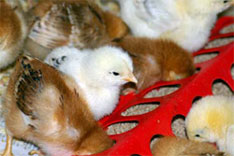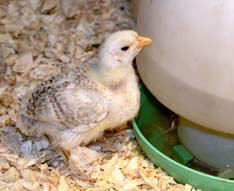



Keeping Garden Chickens in North Carolina - 1
A useful guide to keeping chickens for the hobby farmer from North Carolina State University Cooperative Extension. This first part covers the first steps, including selecting your birds and when to bring them home.
Chickens can be a colourful, beautiful, entertaining addition to your garden, and a few hens in your backyard can supply all the eggs your family needs, along with litter (manure mixed with bedding) that can be used as a source of organic fertilizer. Your hens will supplement their diet with bugs and grubs, and they can turn your garden and kitchen waste into tasty eggs. No wonder you are interested in raising chickens!
Do Your Homework First
Before ordering your chicks, you should consider several issues. First of all, if you live within the city or town limits or in a restricted subdivision, ordinances or covenants may prohibit keeping poultry on your property or limit the types and number of birds you can raise. Even modern ordinances allowing garden hens usually prohibit roosters. A call to your local animal control or zoning office prior to ordering your birds will allow you to make an informed decision on what types and how many birds to order. If there are livestock restrictions that are being applied to pet garden hens, consider gathering a group of like-minded individuals to follow the proper channels to change those regulations so that garden hens are allowed. Use modern ordinances, such as those for Raleigh, as a guide.
Once you have determined that it is legal for you to keep poultry, think carefully about your ability to provide the necessary care. A home flock needs fresh food and water every day, you must gather eggs every day, and you must make sure that the flock always has a clean, dry shelter. This means that someone must be available to care for the birds seven days a week, every week. Do not be surprised, however, if you find a number of your friends are willing to occasionally babysit your flock. Many people are charmed by laying hens and enjoy the chance to visit (hen-sit) them to provide food and water, knowing they will find a gift of fresh eggs in the nest box.
The Fun Begins: Selecting Your Chickens
Once you are certain you are ready to raise your own hens, the next decision is how many birds you should keep. Consider the size of the available area for your coop and run, and your individual or family consumption of eggs. Small housing units that may be perfect for an urban or suburban setting may house only two or three birds comfortably. Each hen will produce around two eggs every three days, up to 15 dozen eggs, during her first laying year. The number of eggs produced by each hen then declines yearly. Those same hens will produce about two eggs every four days, or up to 12 dozen eggs in year two. Choose the number of hens that will meet your egg needs (including eggs to give away to friends and neighbours if you plan to share), and that will fit in the housing you have without overcrowding.
Be sure to read the section about housing, and make sure you finalise your coop plans before deciding how many chicks or pullets to order. Keeping space restrictions in mind when making this first, essential decision will ensure that you do not overcrowd your first flock. Think also about your neighbours and about noise: hens are fairly quiet, and noisy roosters are not necessary to get a full harvest of eggs. Without a rooster, hens will lay unfertilized eggs, which is what most people eat. With a rooster, hens will lay fertile eggs that can be hatched into chicks. For most residential settings, a small flock without a rooster is the best choice. For the safety and health of your hens, flocks of less than 10 birds should not have a rooster.
You can start your flock in one of three ways: with day-old chicks (the least expensive but riskiest, most work-intensive choice); with young female birds, called pullets (slightly more expensive if you buy locally, quite a bit more if you order from a large supplier and must pay shipping, but ready to put into your coop without going through the brooding process); or with mature hens (if you can find a source and can trust that the hens are no more than a year or so old). If you are going with day-old chicks, to make sure you end up with the proper number of healthy laying hens, purchase one or two more sexed (known female) chicks than the final minimum number you hope to have in your flock. This allows for the possible death of a chick or two during brooding.
Unless you know, without question, that you have a good home where you can send unwanted young roosters, do not purchase ‘straight run,’ mixed male and female chicks, and do not hatch your chicks from eggs for your garden laying flock. It may be difficult to find homes for unwanted roosters, and you do not want to add to the problem of unwanted domestic animals. Tell your day-old chick supplier that you absolutely do not want male chicks added to your order as ”packing peanuts“ to help keep your female chicks warm. Combine orders with others to have enough female chicks so that these extra males are not needed.
If you are purchasing started pullets or already laying hens, purchase a number equal to or only one higher than your final minimum goal. If you start with day-old chicks, consider the time of year. Chicks started in October or November (or pullets from late fall started chicks) will be more productive in their first year than chicks started in March or April, especially if you live in a part of North Carolina with mild winters.
Once you decide how many hens to raise, it is time to choose a breed. If collecting slightly less than one egg per day, per hen, in that first year is adequate for you, and you would like hardy hens that produce regularly over a longer period of their lives, consider some of the heritage breeds. You can find a list of heritage chickens, broken down into categories based on the current status of the breed, at the Web site for the American Livestock Breeds Conservancy — Conservation Priority List. (Poultry Breed Information, American Livestock Breeds Conservancy Priority List. http://www.albcusa. org/cpl/wtchlist.html)
Barred Rocks and Rhode Island Reds are two heritage breeds that perform well in North Carolina, but others will do just as well. Another list of chicken breeds you can review, which describes the color, size, weight, origins, egg color, and egg productivity by breed, can be found online at the ICYouSee Handy-Dandy Chicken Chart. (An Alphabetical List of More than 60 Chicken Breeds With Comparative Information, available at http://www. ithaca.edu/staff/jhenderson/chooks/ chooks.html.) Similar information may also be found in the Purdue University publication Choosing a Chicken Breed: Eggs, Meat, or Exhibition. If your goal is to maximize egg production in the first year, and you don’t mind that your hens may have a shorter productive life, then you may choose a commercial breed designed to produce an egg a day, almost every day, in the first year, such as a Leghorn. Keep in mind, however, that these birds are light and flighty, and that maximum egg production in the first year may come at a price: such breeds are designed for short-term, high production, and may not be as hardy, long term, as the heritage breeds. Sex-linked hens, which are hens that have a purebred Leghorn parent (the primary breed used for commercial egg production), usually crossed with one of the heritage breeds, are excellent egg layers and are often chosen for home garden flocks.
If you want both high first-year egg production and hens that can be used for stewing meat when production slows after a few years, consider Plymouth Rocks (including Barred Rock), Rhode Island Reds, New Hampshires, Sussex, or Wyandottes. Note, however, that these ”dual purpose“ breeds do not lay as many eggs as the commercial egg-laying breeds and do not produce as much meat as commercial meat breeds do. They are, however, hardy, proven breeds that should do well in a backyard garden flock.
When You Bring Home Your New Chicks, Pullets, or Hens


If you decide to start with day-old chicks, you will need special equipment to care for them when they arrive. Day-old chicks must be kept warm in a brooder, which you can construct from a cardboard or plywood box, for the first three weeks or so. A box 2 feet wide by 3 feet long and 18 inches deep will house 25 chicks. Adjust the size based on the number of chicks you are rearing. Place clean, dry wood shavings, dry sand, or other absorbent material in the bottom of the box. You can place a wire floor (½ inch by ½ inch wire) mounted on a frame of small lumber over the absorbent flooring materials, or the chicks can be raised on the absorbent flooring material itself.
Chicks have down rather than feathers for the first few weeks of life and cannot maintain their own body temperature without supplemental heating. Keep the chicks warm by mounting a single light bulb (100 watts should be enough in mild weather) inside a reflective shield (such as a metal can or mechanic’s light) about eight inches above the floor of the box.
If the chicks huddle under the lamp, a sign that they are cold, the lamp may be lowered slightly, or a higher wattage bulb may be used. If the chicks move away from the light or are panting, a sign that they are too hot, raise the bulb or lower the wattage. Leave the bulb on all day and night during the first three weeks. By then the chicks should be about half feathered, and heat can be reduced. When well feathered, the chicks can be moved out to an unheated poultry house, but do not mix new pullets with older hens. They may not be able to compete for food and may be seriously injured by the hens.
If you start with fully feathered young hens (pullets), or mature laying hens, you will not need supplemental heat. These birds can be placed directly into your enclosed, dry hen house. Place two to three inches of pine shavings – which can be purchased in bales as animal/pet bedding – on the floor of the enclosed coop space to help absorb moisture from the chicken manure. Stir the bedding daily, and remove it when it no longer is absorbing moisture, or when you begin to notice a strong odor. The bedding/manure mixture can be composted to use as fertiliser.
This series will continue on ThePoultrySite in the coming weeks.
July 2010








